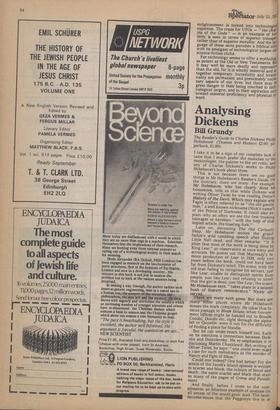Distorting mirrors
Peter Ackroyd
Cults Of Unreason Christopher Evans (Harrap £3.00) When I was a boy, the questions and answers of the Roman Catholic catechism were drummed into me. I still remember the first responses: Who made you? God made me. Why did God make you? God made me to know him and to love him. The flat and assertive tone of this never bothered me. It was, as we say nowadays, irrational but I accepted the statements in the same way as I accepted those of history and geography. I can't remember Any time when I questioned them or ceased to believe them — they simply disappeared.
It is the thesis of Dr Evans's book that this kind of faith has disappeared also on a much larger scale. That the mythic and moral structure of Christian faith has all but yielded to the texts and statistics of contemporary science. Of course this is a familiar and rather portentous argument, and it takes a lot of skill to make it something other than a cliché. But Dr Evans really doesn't argue his case. He tells some funny stories instead. His book is more or less a grand tour of what he calls "cults of unreason" (covering scientology, flying saucers, radionics and yogi) which "fill the gaps in cosmology" — the gaps between an unscientific Christianity and unphilosophical science, nineteenth-century morals and twentieth-century whizz-kids. Or so the introduction says.
The actual substance of the book is devoted to the cranks and the pranks of these modern bie businesses known as religion. Scientolo
gY, naturally enough, comes out with most of the scars. The life of L. Ron Hubbard — the 8y, Daddy of the movement — is lovingly detailed from his start in ' dianetics ' to his communications with tomatoes, and to his later adventures as a Sea-Org. Read the book for the key. And read it also to find out why Jesus is alive and well on Venus, what happened to Dr Walter Wumpe, why the flying saucers came to Warminster, and what a gizmo is.
, But the implications of Dr Evans's survey,„ have their serious side, for it is his point that these twentieth-century cults are an index of the shape of things to come.' Strong Words, but the point is there. For it is difficult to tell whether these cults act more as paroP;es or paradigms of established religion. ley are often squalid and facile, but their development and their concerns offer a disCorted mirror-image of organised Christianity.
Th, ese are the aspects which Dr Evans un'leritnes. I will leave on one side the financial intrigues of the cults (although this may have 8,Orne bearing on their similarity to estahIls,,hed religions) and consider instead the simP,'IcitY of their message. They fabricate an upi-the-rninute Golden Place (whether it be a enus or an orgone box). They afford neat rki suitable technical explanations for life aan,,d history, They promise the escape from ," °Id identity, and a new purity: the sciento*gists will bring forth Clears, or the superior sPeeirnens of the human race; the electrometer will free us of tension; the Eastern Yogi will free us of ourselves. These messages are not unique to contemporary cults of un r eason, but neither are the attendant dangers, , For in cults like scientology there is a rapid ,Vd inevitable spread of authoritarianism and reaucracy. L. Ron Hubbard sends ' Ethics Issions ' to ' Orgs,' with supreme power of `MMinand. There is an elaborate hierarchy of e.nlightenment, and one of the lowest classes 1:s1 that of ' Non-Existence "Here not only Plthing, shaving, make-up are barred, but individuals must wear old clothes which they may not change." This seems to be a facile tand rather mundane version of the state of i khe sinful soul in more orthodox faiths. And t as if the moral precepts of established faith Which have become looser and more aethei la] over the last few years — were re-enacted o their most tangible forms, t is at this point that we understand the distinction between contemporary cults of unreason and the more spiritualised but FLuaily irrational commands of Christianity. he motives and aspirations remain the same,
is their embodiment which has changed. Or these twentieth-century cults, the only
reality is a material one, or at least one that can be measured in material terms. The need or electrometers, orgone boxes and E-meters .7-• What Dr Evans labels as "the black box" mentality — is one example of how spiritual enlightenment is turned into technologic! expertise. The craze for UFOs — "the charti ots of the Gods" — is an example of 10. deity is seen in terms of superior transporl rather than of superior morality. And the lat!' guage of these sects parodies a biblical stylf with its amalgam of technological jargon and science-fiction cliche.
For technology seems to offer a mythologY as potent as the Old or New Testaments. Bul it may well be more deadly and oppressive than the old, for it is wholly material and al' together temporary. Incredulity and irratio. nality are permanent and presumably neces. sary aspects of our lives, but there may V great danger in their being couched in tech' nological jargon, and in their aspiration onl!' toward material proficiency and physical re ward.
































 Previous page
Previous page